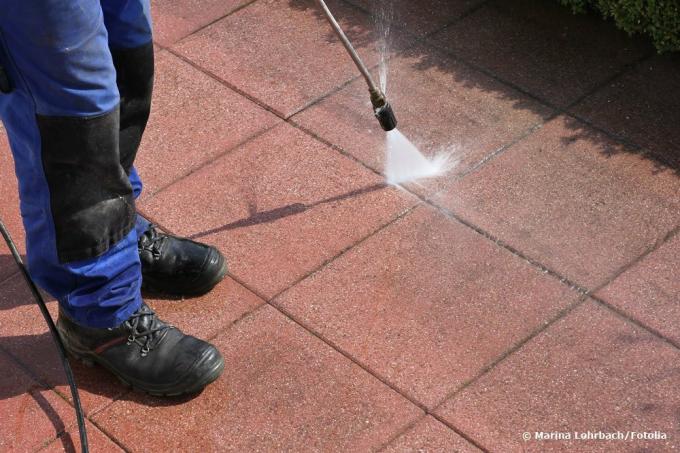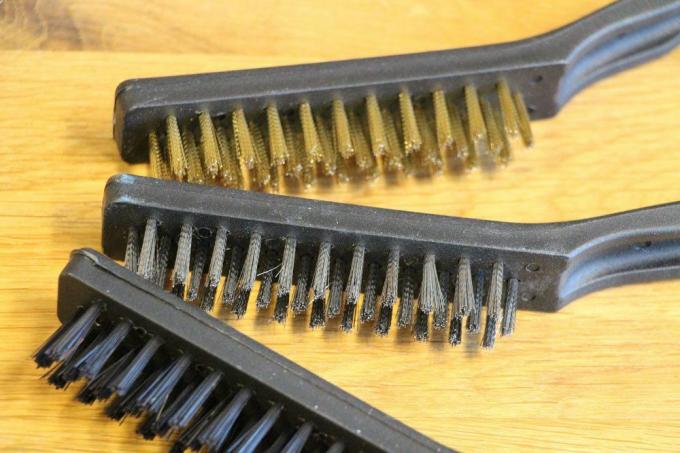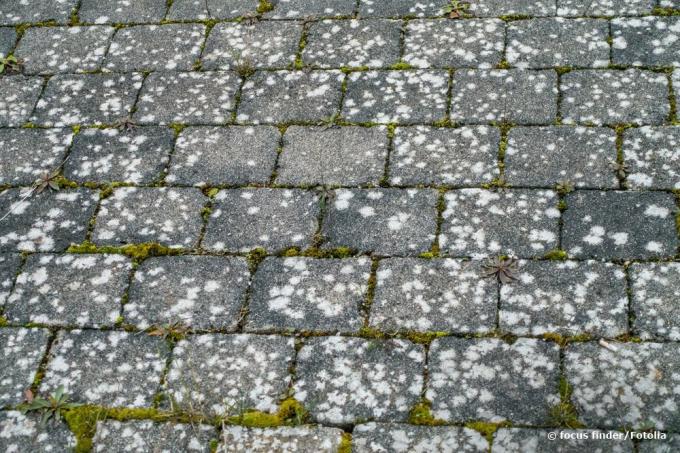
table of contents
- Remove lichen
- Tools
- Wire brush
- Wire broom
- Brush with soft bristles
- Home remedies
- high pressure cleaner
- Boiling water
- Baking soda
- Burn lichen
Lichen is one of the most stubborn coatings that can settle on paving stones. The symbiotically living together fungi, bacteria and algae can only be removed with great effort and many people use the chemical club for this. However, you do not have to rely on chemistry immediately, because suitable home remedies can be found with which you can fight lichen without any problems. The application takes some time, but is effective against the deposit.
Remove lichen
Tools
Before you use the liquid home remedies, you should equip yourself with the right tools. The deposit doesn't just disappear through the use of the remedies, you have to do it yourself. It is therefore advisable if you have one of the following utensils available:
Wire brush
Wire brushes are handy and come in different strengths. This makes them ideal for combating lichen, as different brush sizes can be used more effectively for the area to be treated. Brushes are above all
for small areas to be recommended, as these can be used with pinpoint accuracy. When choosing the right wire brush, you should make sure that the bristles are close together in order to work more effectively against the lichen. A disadvantage of the wire brush is that it requires a lot of force, as you are working directly on the ground.Wire broom
The wire broom is a controversial device when it comes to removing lichen. The reason for this is the fact that the sturdy wire bristles roughen the floor and for this reason promote the development of lichen on smooth floors or wood. Since paving stones have a rough surface from the ground up, the use of a wire broom is unproblematic and is particularly useful for one persistent infestation at. The wire broom should have the following properties to be effective against the lichen:
- Bristles should be durable so they don't break or bend immediately
- the stem should be at least 2.5 cm in diameter
- a wooden broom is more stable than plastic, as more pressure can be built up during use
The big advantage of the wire broom over the brush is the ability to do it yourself large areas treat in shorter working hours. In addition, you don't have to work on the floor and can easily scrub while standing. However, wire brushes are better suited for small areas because you can work more precisely with them.
Brush with soft bristles
Such brushes are good for braids that don't stick too tightly. Some lichens, especially the white ones, cannot be loosened with conventional brushes. However, they are suitable for lichen in colors other than white. These do not adhere too strongly and can easily be removed with the brushes without wire bristles. This should just be big enough. Alternatively, choose a classic scrubber. The best thing about this variant: the surface is less roughened.
The decision should be made based on the size of the area to be treated. If you plan to clean 20 m² with a wire brush, you can be prepared for strenuous hours. Once you have decided on one of these tools, consider using any of the following four home remedies to help deal with lichen.
tip: If you don't mind the sight of the lichens, you could theoretically leave them alone. Lichen is an indicator of clean air, so it's not as common in cities as it is in the countryside.
Home remedies
high pressure cleaner
In this sense, the high-pressure cleaner is not a household remedy, but many do-it-yourselfers and gardeners have one in their garage or garden shed. Water works effectively against the lichen as soon as there is enough pressure behind it is what makes the pressure washer very effective. Like the wire broom, the device should only be used for braiding rough Surfaces, so it is well suited for paving stones. Another advantage is the ability to use the high-pressure cleaner in bad weather, as no liquid agents are used. To use it, proceed as follows:
- look at the area to be treated
- in many cases you not only have to treat the lichen with the water jet, but also the stones around it
- in this way you prevent a possible settlement of spores that have settled there
- switch on the pressure washer
- You can use a high setting for cobblestones if your device allows it
- however, you should use a low setting for joints made of loose sand or sludge new sand afterwards
- Now slowly drive the high-pressure cleaner over the surface to be treated
- the color of the cobblestones should visibly change as the lichen is removed
- continue doing this until all of the lichen is removed
- Finally, rinse it away with the garden hose

Pressure washers are best for large-scale infestation. For small areas, other measures are more effective and use less water.
tip: You have to be prepared for the fact that paving stones have to be stripped of lichen more often than other floors. The reason for this is the rough surface, which permanently favors the settlement of the covering.
Boiling water
If the lichens are still quite new, boiling water is good for loosening the plaque. All you need is a kettle or pot and a brush with soft bristles. Boil the water, then pour it over the lichen. Now take the brush and scrub off the base. You don't necessarily need a lot of strength for this, because the hot water loosens the connection between the lichen and the floor, which makes scrubbing easier. Then rinse the lichen away. However, this method is only temporarily, because the lichens can settle again within a short time.
Baking soda
Baking soda is one of the most important home remedies and can even be used effectively for lichen. It should only be at dryweather can be used as rain can wash away the powder without any problems. In addition, the following day should also be free of rain. You need:
- broom
- 20 g of baking soda per 10 l of water
- Wire brush or broom
- bucket

The larger the area, the more baking soda solution you need to make. You should therefore mix these on site and, as a precaution, have additional packets of the powder ready.
1. Thoroughly clean the paving stones beforehand with a broom. This will remove dust and dirt that could reduce the effectiveness of the baking soda solution.
2. Take a large bucket and fill it with water. Now add baking soda accordingly and stir thoroughly with a stick. Make sure that no lumps form.
3. Spread the solution generously over the infested areas. Every single stone must be covered with the baking soda solution and it is often necessary to treat neighboring areas as well, as spores could also be found on them.
4. Leave the solution on overnight to permanently loosen the lichen from the paving stones. An exposure time of 24 hours is recommended to remove even stubborn deposits.
5. After the exposure time, brush the entire surface. Depending on the severity of the infestation, the use of wire brushes or brooms is also worthwhile.
6. Finally, the paving stones are rinsed off. After treatment with baking soda, the soil is protected from spores for a long time. However, this depends on the weather, because the wetter it is, the higher the likelihood of a new outbreak. Keep paving stones as dry as possible to prevent settlement.
tip: Avoid using vinegar or citric acid. While these home remedies are extremely effective against the buildup of fungus, bacteria and algae, they can Permanently damage the paving stones, lead to stains and pollute your garden, which is what dying plants do everything race, caused.
Burn lichen
Fire is one of the most effective remedies for lichen. Not only are these completely removed, but the floor is also cleaned of other spores that would encourage the formation of fresh deposits. In contrast to the high-pressure cleaner and the use of boiling water, this variant is a long-term effect that you do not have to use as often. The best thing: many gardeners already own a weed burner or they can be obtained for prices of 20 to 40 euros. To use it, proceed as follows:
- connect the weed burner to the gas bottle
- turn it on
- Now guide it carefully over the lichen so that it starts to burn
- keep doing this until all of the lichens are burned off
- then clean the stones with a broom

tip: As an alternative to the weed burner, only use a bunsen or gas burner if you are familiar with them. The risk of getting burned is higher with these devices and they also do not work quite as effectively.


